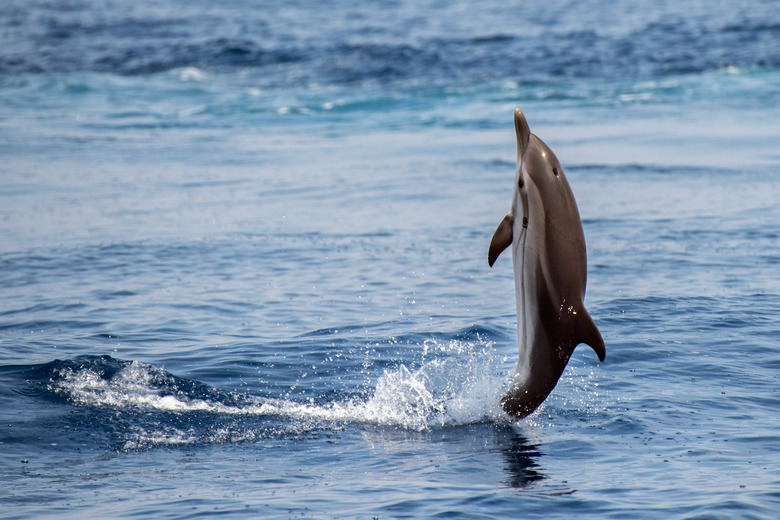Three Adaptations For A Dolphin
Dolphins can be found in many bodies of water, from almost every ocean to large rivers such as the Amazon. All 40 recognized dolphin species have captured the human imagination for their playful disposition, advanced intelligence, and keen hunting senses. Though human intervention has long plagued these creatures, they thrive in their watery homes thanks to a wide range of evolutionary adaptations, ranging from echolocation to social skills to blowholes.
Swimming Ability
Swimming Ability
For their size, dolphins are among the fastest and most agile swimmers in the world. This adaptation increases hunting skill and ability to avoid predators. Bottlenose dolphins can reach speeds of over 18 mph. Dolphins can leap up to 20 feet out of the water. According to Defenders of Wildlife, "Scientists believe that dolphins conserve energy by swimming alongside ships, a practice known as bow-riding."
Echolocation
Echolocation
Using a similar principle as ship radar, dolphins bounce sound off objects to ascertain their shape and properties. This adaptation helps them communicate with other dolphins, avoid predators and hunt when light conditions are not optimal. Dolphins generate up to 1,000 clicking noises per second. According to Sea World, the forehead of a bottlenose dolphin contains a fat-filled organ called the melon that focuses sound clicks into a beam for purposes of echolocation. Cavities in the lower jaw bone receive the echoes and the brain interprets the results.
Group Hunting
Group Hunting
Some dolphin species hunt well in groups. According to Sea World, bottlenose dolphin groups (known as pods) occasionally encircle a large school of fish, herding them into a dense mass. Individual dolphins then charge the mass to feed, one at a time. This behavior shows the advanced social adaptation of a dolphin's brain.
Other Adaptations
Other Adaptations
Dolphins have a blowhole that allows the mammal to take in air at the surface. This blowhole is covered by a flap that provides a watertight seal. Dolphins have keen eyesight, with good vision above and below the water. They have an adaptation that gives them two stomachs. One stomach stores food and the other digests it. Relative to their size, a dolphin has a very large brain. According to Sea World, "One likely theory is that a larger brain size in dolphins may be at least partially due to an increased size of the auditory region to facilitate sound processing."
Cite This Article
MLA
Fielder, Dan. "Three Adaptations For A Dolphin" sciencing.com, https://www.sciencing.com/three-adaptations-dolphin-8640606/. 19 April 2018.
APA
Fielder, Dan. (2018, April 19). Three Adaptations For A Dolphin. sciencing.com. Retrieved from https://www.sciencing.com/three-adaptations-dolphin-8640606/
Chicago
Fielder, Dan. Three Adaptations For A Dolphin last modified March 24, 2022. https://www.sciencing.com/three-adaptations-dolphin-8640606/
